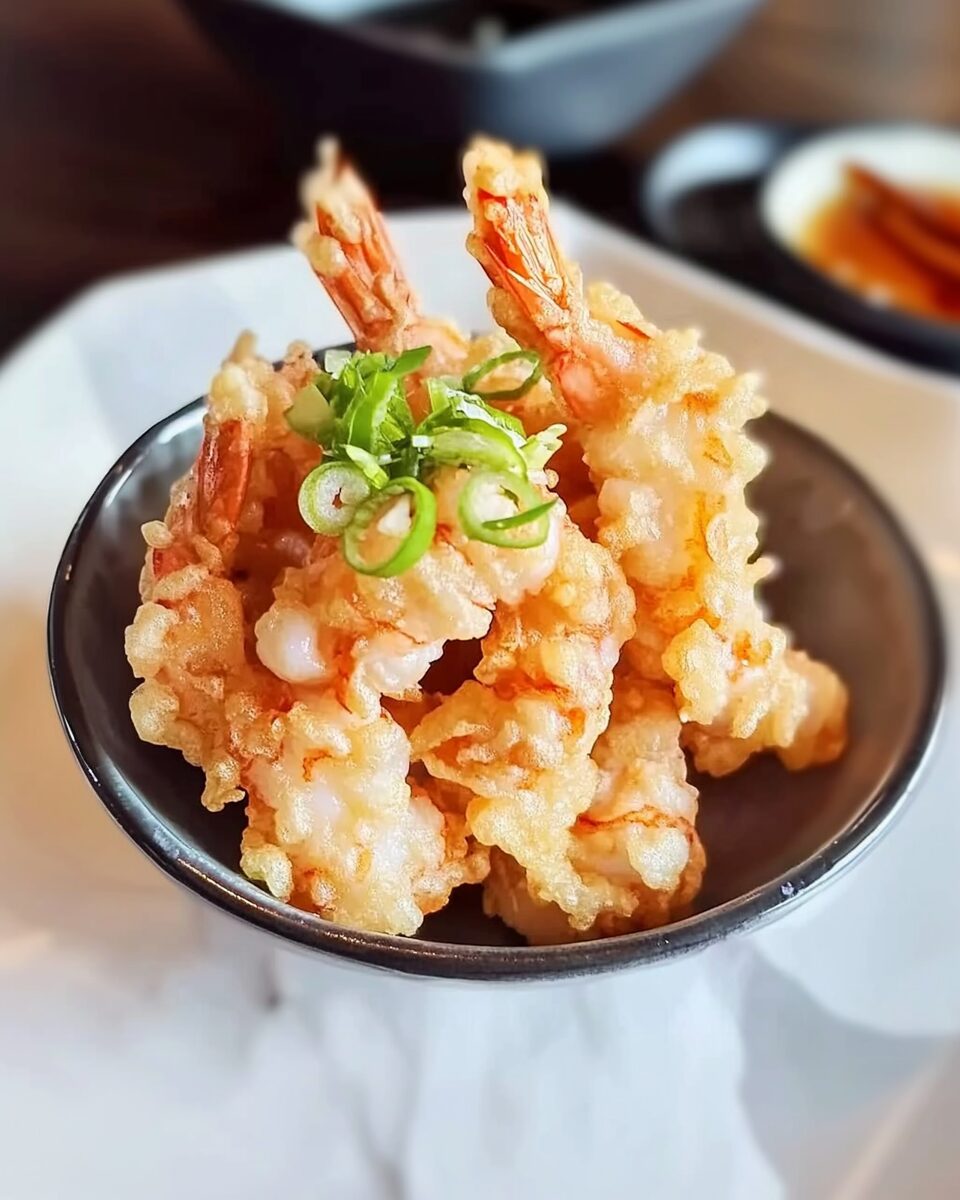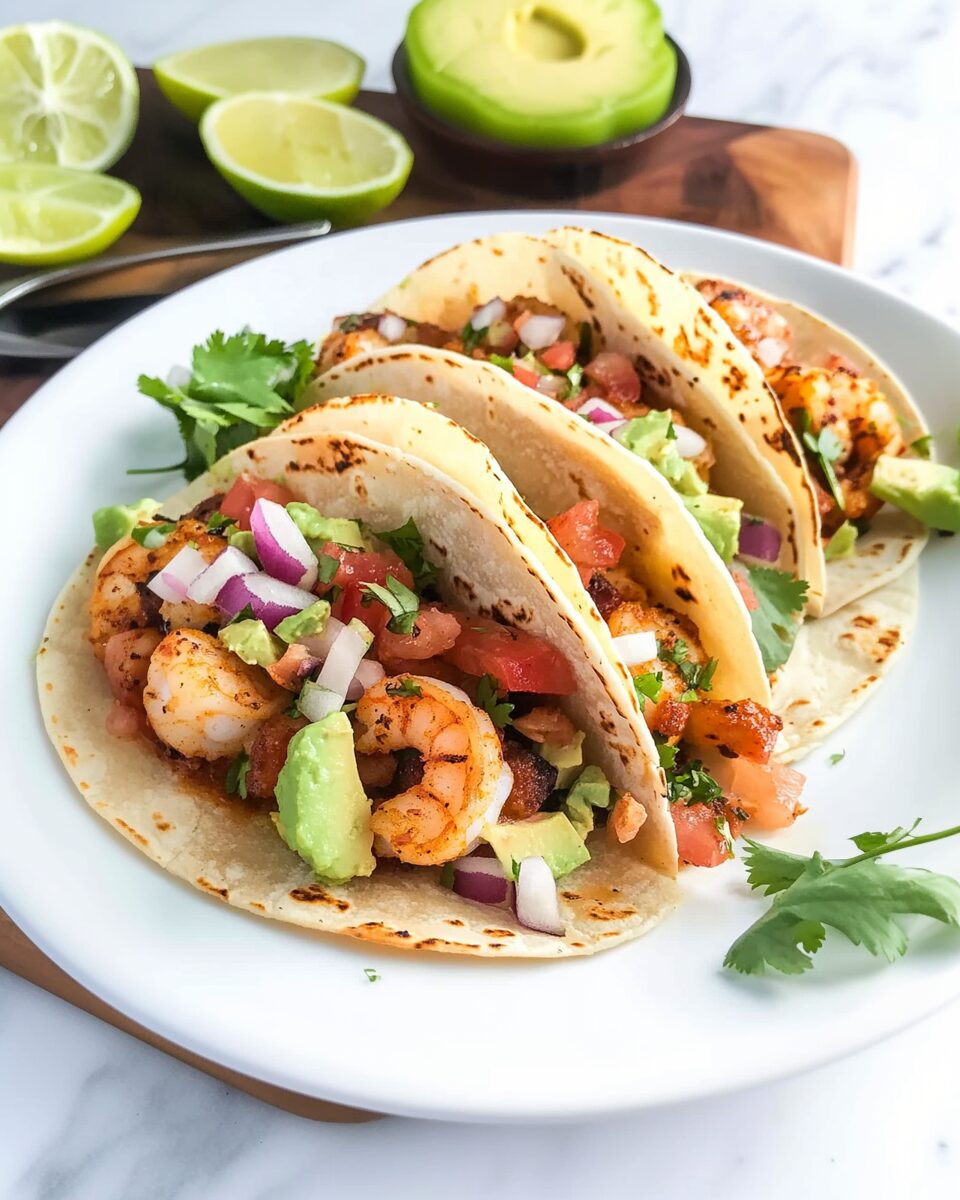Shrimp Tempura is a classic Japanese dish known for its light, crispy batter enveloping tender shrimp. This recipe brings the authentic taste of Japanese cuisine to your kitchen, offering a delightful appetizer or main course that’s both elegant and satisfying. Perfect for special occasions or a gourmet weeknight dinner, Shrimp Tempura pairs wonderfully with a traditional dipping sauce, enhancing its delicate flavors.
Full Recipe:
Ingredients
- 12 large shrimp, peeled and deveined
- ½ cup all-purpose flour
- ½ cup cornstarch
- 1 egg, beaten
- 1 cup ice-cold water
- ½ teaspoon salt
- Vegetable oil, for deep frying
- Optional: sliced green onions for garnish
Directions
- Prepare the Shrimp: Pat the shrimp dry with paper towels. Make small incisions along the underside to prevent curling during frying.
- Make the Batter: In a bowl, mix flour, cornstarch, and salt. Add the beaten egg and ice-cold water, stirring gently to combine. The batter should be slightly lumpy; do not overmix.
- Heat the Oil: In a deep pan or wok, heat vegetable oil to 350°F (175°C).
- Fry the Shrimp: Dip each shrimp into the batter, allowing excess to drip off. Carefully place into the hot oil, frying in batches to avoid overcrowding. Cook for about 1½ minutes or until golden brown.
- Drain and Serve: Remove shrimp with a slotted spoon and drain on paper towels. Serve immediately, garnished with sliced green onions if desired, alongside a dipping sauce.
Nutrients (Per Serving – Approximate)
- Calories: 354 kcal
- Carbohydrates: 54g
- Protein: 22g
- Fat: 3g
- Saturated Fat: 0.7g
- Cholesterol: 189mg
- Sodium: 1450mg
- Fiber: 5.6g
- Sugar: 4.5g
- Vitamin A: 4690 IU
- Vitamin C: 12.5mg
- Calcium: 136mg
- Iron: 4mg
The Art and Science of Creating the Perfect Tempura Batter
What makes shrimp tempura stand out is the ultra-light and crispy batter that sets it apart from other fried foods. The secret lies in the batter’s ingredients and preparation. Unlike typical fried batters that rely on thick coatings, tempura batter is made with minimal ingredients — usually just flour, cornstarch, egg, and ice-cold water — and is mixed very lightly to avoid gluten development, which can make the coating dense and heavy.
The use of ice-cold water is critical because it slows the formation of gluten and helps produce a batter that fries up thin and crisp. When combined with hot oil at the correct temperature, this batter immediately crisps without absorbing excess oil, resulting in a delicate crunch and light texture. The batter also forms bubbles as it fries, which contributes to its signature airy appearance.
Mastering the frying temperature is another essential element. Too hot, and the batter burns before the shrimp cooks through; too cool, and the batter becomes greasy and soggy. Maintaining an oil temperature around 350°F (175°C) is ideal for achieving that golden, crisp exterior.
Why Shrimp is the Ideal Tempura Ingredient
Shrimp is a popular choice for tempura for several reasons. Its firm yet tender texture contrasts beautifully with the light batter, creating a pleasing mouthfeel. The natural sweetness of shrimp also complements the mild, slightly savory batter and traditional dipping sauces, such as tentsuyu—a mixture of soy sauce, mirin, and dashi.
Additionally, shrimp cooks quickly, which is ideal for the quick frying process needed for tempura. The precise timing ensures the shrimp remains juicy and succulent inside while being perfectly crisp outside. This balance of textures and flavors makes shrimp tempura a dish that is both simple and sophisticated.
Shrimp tempura is often served with a side of grated daikon radish, lemon wedges, or a light soy-based dipping sauce to enhance its fresh flavors without overpowering the delicate batter or seafood.
Variations and Modern Twists on Shrimp Tempura
While the traditional shrimp tempura recipe remains a classic, modern chefs and home cooks have experimented with a variety of creative twists. Some variations incorporate different batters, such as adding sparkling water or soda to increase the batter’s lightness and crunch. Others may add a hint of spice, like chili powder or paprika, to the batter for an unexpected kick.
Shrimp tempura can also be paired with an array of dipping sauces beyond the classic tentsuyu, including spicy mayo, ponzu sauce, or even sweet chili sauces, adapting the dish to various flavor preferences and fusion cuisines.
In addition, shrimp tempura has found its way into innovative dishes such as sushi rolls, tempura tacos, or even tempura salads. These adaptations show the versatility of shrimp tempura and its ability to blend with global culinary trends while maintaining its core identity.
Nutritional Aspects of Shrimp Tempura
Shrimp tempura, while delicious and relatively light compared to other fried foods, still contains calories and fats from the frying process. Shrimp itself is low in calories, rich in protein, and contains essential nutrients like vitamin B12, selenium, and omega-3 fatty acids, which support heart and brain health.
The batter and frying oil contribute carbohydrates and fats, so moderation is key for those monitoring calorie intake. Using healthier oils with high smoke points, such as avocado or peanut oil, can improve the nutritional profile. Air-frying is another alternative method gaining popularity, offering a way to enjoy tempura with less oil while retaining a crispy texture.
Shrimp tempura is also naturally gluten-containing due to the flour in the batter, so gluten-free adaptations using rice flour or other gluten-free starches have become popular among those with dietary restrictions.
Serving Suggestions and Pairings
Shrimp tempura is incredibly versatile and can be served in numerous ways. As an appetizer, it pairs beautifully with light dipping sauces and fresh garnishes like lemon wedges or grated daikon radish to cleanse the palate. When served as part of a main course, it can accompany steamed rice, miso soup, and pickled vegetables for a traditional Japanese meal experience.
In fusion cuisine, shrimp tempura can be the star of sushi rolls or served alongside Asian-inspired salads for a crunchy contrast. It also works well in bento boxes or as finger food for parties and gatherings.
For beverages, green tea, sake, or light Japanese beers complement the subtle flavors of tempura without overwhelming the palate.
Tips for Perfecting Shrimp Tempura at Home
Achieving restaurant-quality shrimp tempura at home is easier than many think, provided you follow a few key tips. Always use fresh, high-quality shrimp and make sure they are properly deveined and patted dry to ensure the batter adheres well. Keeping your batter cold and mixing it just enough to combine ingredients prevents heavy gluten development and helps maintain crispness.
Frying in small batches avoids overcrowding the oil, which can drastically reduce the temperature and result in greasy tempura. Using a thermometer to monitor oil temperature can help maintain the ideal frying environment.
Finally, serving shrimp tempura immediately after frying ensures the best texture and flavor. If needed, keep fried tempura warm in a low oven while finishing batches but avoid covering it tightly, which traps steam and sogginess.
Conclusion
Shrimp tempura is a culinary treasure that combines history, technique, and flavor in one delightful dish. Its origins reflect the cultural exchanges that shaped Japanese cuisine, while its preparation exemplifies the artistry and precision Japanese cooking is known for. The balance of light, crispy batter and juicy shrimp creates an irresistible texture and taste that has captivated food lovers worldwide.
Beyond its deliciousness, shrimp tempura offers versatility in presentation and adaptability in recipes, allowing both traditionalists and modern cooks to enjoy and experiment with this classic. Whether served in an elegant restaurant setting, at home for a special meal, or incorporated into fusion dishes, shrimp tempura remains a symbol of culinary excellence and enjoyment.








